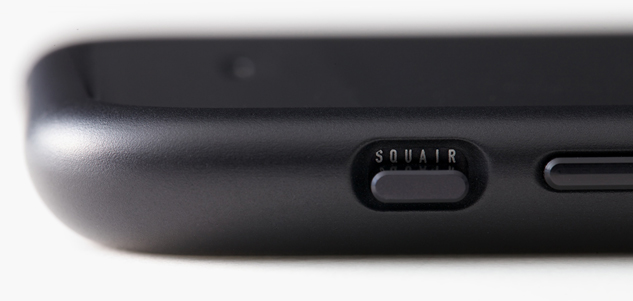A report on Wednesday claims Apple's next-generation iPhone may employ a curved chassis design and accompanying display glass, a vast departure from the substantially squared-off design used on existing Apple handsets.
Citing a "trusted source," Japanese blog Mac Otakara reports the so-called "iPhone 6" will sport "rounded" edges and a curved display glass much like the design seen on Samsung's Galaxy S III. The publication's sources have a decent track record in predicting future Apple product designs, especially regarding displays and screen tech.
Aside from the Galaxy S III, Apple's supposed iPhone design is akin to an existing iPhone bumper made by Japanese company Squair (seen above). The metallic bumper, made out of Duralumin, features a largely rounded-off edge that protrudes from the iPhone's chassis. It is unclear if the iPhone 6 will boast such a severe curvature.
To accommodate the rounded edges, a slightly curved display glass is also said to be part of Apple's design plans. Based on what can be gleaned from the report, it seems like the top glass will not feature a convex face, but rounded edges to sit flush with the chassis.
Finally, the iPhone 6 will do away with the dual glass-covered antenna windows seen on the back of iPhone 5 and 5s models, the source said. It is unknown what method of radio transmission will be utilized in the upcoming handset, though Apple will likely take steps to avoid another "antennagate" debacle.
Earlier this month, KGI analyst Ming-Chi Kuo said in a research note that Apple would release two new iPhones this year, a 4.7-inch version and a larger phablet-style 5.5-inch model. Kuo believes the 4.7-inch iteration will use a 1,334-by-750-pixel display with a resolution of 326 pixels per inch in a bid to maintain congruency with current apps. The 5.5-inch version would be a more traditional 1,920-by-1,080 pixels, which translates to 401ppi.
 Mikey Campbell
Mikey Campbell








 Brian Patterson
Brian Patterson
 Charles Martin
Charles Martin


 Malcolm Owen
Malcolm Owen
 William Gallagher
William Gallagher
 Christine McKee
Christine McKee
 Marko Zivkovic
Marko Zivkovic









45 Comments
This is good news!! I personally detest the squared off design and the sharp edges. This will be a nice change (if it is true)
So basically the new iPhone will have an iPod touch/iPad style design.
I'm sure it will be nice, but I'm definitely into the defined edges the iPhone has had since 4. If some how the glass is curved to increase one handed use, then that will be cool though.
[quote name="Rogifan" url="/t/178794/rumor-apples-iphone-6-may-sport-curved-edges-display-glass#post_2521762"]So basically the new iPhone will have an iPod touch/iPad style design.[/quote] The article says like the Samsung Galaxy S III. For the clickbait.
[quote name="Suddenly Newton" url="/t/178794/rumor-apples-iphone-6-may-sport-curved-edges-display-glass#post_2521764"] The article says like the Samsung Galaxy S III. For the clickbait.[/quote] Click bait is usually the title. No way of telling that there's a SGS 3 reference until after you've clicked on it.